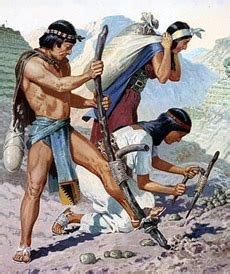Introduction

The Mita System was an integral part of society in the Inca Empire, a vast and highly organized empire that spanned much of western South America from the 13th to the 16th centuries. The system regulated the allocation of labor and land among the empire’s population and played a crucial role in maintaining the empire’s economic and social stability. In AP World History, understanding the Mita System is essential for comprehending the rise and fall of the Inca Empire.
Definition
The Mita System was a labor draft system enforced by the Inca government, whereby all able-bodied adult males were required to work in service to the state for a specific period of time each year. This labor could take various forms, including:
- Agriculture: Working on imperial lands or contributing to surplus production
- Public works: Constructing or maintaining roads, bridges, and buildings
- Military: Serving in the Inca army
- Other services: Working in mines, workshops, or as messengers
The duration of Mita service varied depending on the type of work performed and the region of the empire, but generally ranged from one to three months per year.
Structure and Administration
The Mita System was highly structured and administered by a complex bureaucracy. Each community (ayllu) was responsible for providing a specific number of workers to the state. The Inca government maintained detailed records of the labor obligations of each individual and tracked their compliance. Local leaders were tasked with ensuring that Mita quotas were met and that workers were treated fairly. The system also allowed for some exemptions, such as for elders, chiefs, and members of the priesthood.
Economic and Social Impact
The Mita System played a pivotal role in the Inca economy. By mobilizing a large workforce, the Inca government was able to undertake ambitious public works projects, expand agricultural production, and maintain a formidable military. The system also provided a means of redistributing wealth and resources throughout the empire, ensuring that all subjects had access to basic necessities.
Social Impact
The Mita System had a significant impact on Inca society. It fostered a sense of community and collective responsibility, as individuals were expected to contribute to the well-being of the state. The system also promoted social mobility, as individuals who excelled in their Mita service could earn status and privileges. However, the Mita System also imposed a heavy burden on the population, particularly during periods of conflict or when labor demands were high.
Decline and Fall
The Mita System functioned effectively for centuries, but it began to unravel following the Spanish conquest of the Inca Empire in the 16th century. The Spanish authorities imposed their own labor systems, which were often more oppressive and exploitative than the Mita System. As a result, the Mita System gradually declined and eventually collapsed, contributing to the social and economic disruption experienced by Andean communities during the colonial period.
Legacy
Despite its eventual decline, the Mita System left a lasting legacy on Andean societies. The system’s principles of communal labor and reciprocity continue to influence community organization and resource management in the region today. The Mita System serves as a testament to the ingenuity and organizational skills of the Inca people, and it remains an important topic of study for historians and social scientists alike.
Conclusion
The Mita System was a complex and influential labor draft system that played a vital role in the Inca Empire. It mobilized a workforce, facilitated public works, redistributed resources, and fostered social cohesion. However, the system also imposed a significant burden on the population and eventually succumbed to the pressures of Spanish colonialism. Understanding the Mita System is essential for comprehending the rise, decline, and legacy of the Inca Empire, a testament to the enduring legacy of Andean societies.
